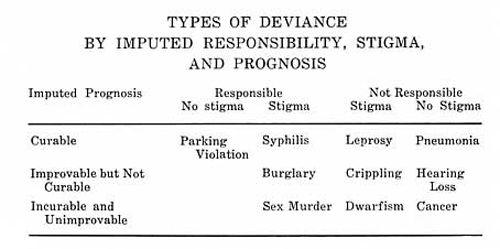The Labeling of Alcoholism and Heroin Addiction
Crimes or Medical Conditions?
Freidson's Typology of Deviant Labels
Eliot Freidson, a medical sociologist, proposed a three-dimensional classification of deviant labels that is useful for understanding different approaches to the control and/or treatment of drug- and alcohol-related deviance (Source: Freidson, "Disability as Social Deviance," 1966). Each dimension of Freidson's typology, which is shown below, focuses on important variations in the meanings or attributes that are typically imputed to particular forms of deviance. The specific examples shown in the cells of the typology (e.g., parking violation) are Freidson's guesses as to the meanings that would be attached to these behaviors or conditions by members of the general public.
The most important distinction in this typology is Imputed Responsibility for the deviant condition: Is the labeled individual responsible or not responsible for the deviance? As shown below, criminal labels, such as burglar or sex murderer cases, generally define individuals as personally responsible for their deviance. On the other hand, medical labels or diagnoses, such as leprosy or pneumonia, tend to define individuals as not responsible for their deviance from a "normal" state of health. This distinction is crucial for understanding social reactions to various forms deviance, because it is closely related to whether individuals receive punishment or therapeutic treatment for the deviant condition.
A second dimension is the Imputed Prognosis for the deviant condition. Some types of deviance are seen as temporary or curable, whereas other types are believed to be incurable. Friedson also includes an intermediate category of improvable but not curable. Imputed prognosis is an important determinant of the degree to which deviants will be segregated or excluded from the community, with incurable deviants often experiencing permanent exclusion or, even, execution.
The final dimension in the typology is based on whether Stigma is attached to the deviance. Although labels that impute responsibility to the deviant are generally more likely to be stigmatized, some medical conditions, such as syphilis or leprosy, carry a stigma and sometimes lead to avoidance and interpersonal rejection.

Perceptions of Alcoholics and Heroin Addicts
Some of the hypothetical examples of deviant types that Freidson presents, such as syphilis or hearing loss, may strike you as misplaced in his typology. What meanings do people actually attach to specific deviant labels, such as "alcoholic" or "heroin addict"? To address this question empirically, Orcutt (Social Forces, 1976) conducted a survey of nearly 1,000 undergraduate students at Florida State University in 1973. He asked them to rate either "alcoholics" or "heroin addicts" on questionnaire items that measured the three dimensions in Freidson's typology. For instance, to measure Imputed Responsibility, students were asked whether they agreed or disagreed that "A person should not be held responsible for being an alcoholic [or a heroin addict]." Based on their responses to this and the other two items that measured Imputed Prognosis and Stigma, students' perceptions of the alcoholic (rated by 495 students) or heroin addict (rated by 465 students) could be placed in one of eight cells of the typology as shown below. The results are shown as tablewide percentages, in which the percentages in the eight cells of each table sum to 100 percent.
As indicated by the modal cell shown in red, both the alcohol and the heroin addict were most frequently typified as responsible, stigmatized, and curable, which more closely resembles a criminal or moral label than it does a purely medical typification. The typification of alcoholics and addicts more-or-less as "criminals" may not be particularly surprising given the historical context of prohibition of alcohol and criminalization of heroin addiction in the United States. These findings also offer some insight into why people in the U.S. continue to support punitive forms of social control that "get tough" with deviant drinkers and drug addicts.
Of course, this study is limited to college students in Florida and was conducted in the early 1970s. Do you think the typification of these forms of deviance would be any different today? How might these labels have changed over time? Do you think members of the adult public would rate alcoholics and heroin addicts differently than did students? Would you expect the findings to differ in other societies, such as those in Europe or the Middle East? Freidson's typology of deviant labels alerts us to fundamental dimensions of meaning that might vary markedly over time or across different social audiences.
Alcoholic (N=495) |
||||
Imputed Prognosis | Responsible |
Not Responsible | ||
No Stigma | Stigma |
Stigma |
No Stigma |
|
Curable |
7.3% | 41.4% | 14.3% | 3.4% |
Not Curable* |
4.2% | 21.4% | 5.5% | 2.4% |
| *Includes both "Improvable" and "Not Curable" |
||||
Heroin Addict (N=465) |
||||
Imputed Prognosis |
Responsible |
Not Responsible |
||
No Stigma |
Stigma |
Stigma |
No Stigma |
|
Curable |
9.0% | 38.5% | 11.0% | 5.2% |
Not Curable* |
3.4% | 24.5% | 5.8% | 2.6% |
*Includes both "Improvable" and "Not Curable" |
||||
| Source: James D. Orcutt, "Ideological Variations in the Structure of Deviant Types: A Multivariate Comparison of Alcoholism and Heroin Addiction," Social Forces 55 (December 1976):419-437. | ||||